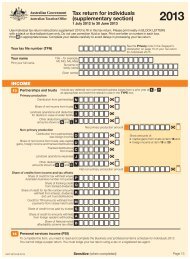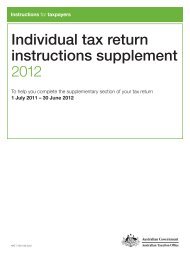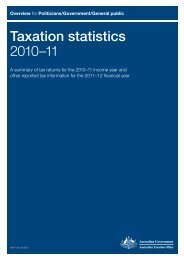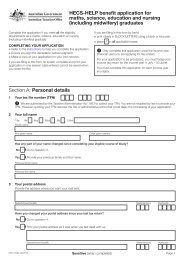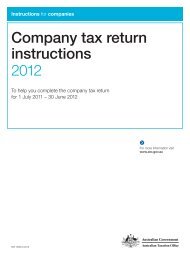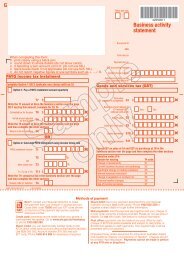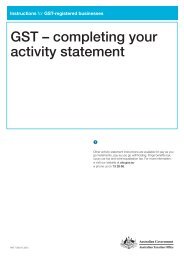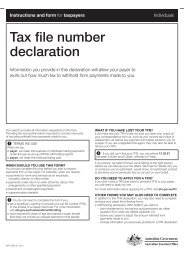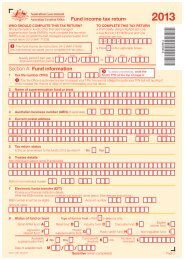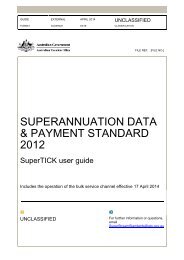Guide to depreciating assets 2013 - Australian Taxation Office
Guide to depreciating assets 2013 - Australian Taxation Office
Guide to depreciating assets 2013 - Australian Taxation Office
You also want an ePaper? Increase the reach of your titles
YUMPU automatically turns print PDFs into web optimized ePapers that Google loves.
A recoupment of the expenditure may be included in yourassessable income.Note that expenditure incurred on or after 19 August 1992 oncertain earthworks constructed as a result of carrying out EPAcan be written off at a rate of 2.5% under the provisions forcapital works expenditure.Mining and quarrying, and minerals transportFrom 1 July 2001, you work out deductions for the decline invalue of <strong>depreciating</strong> <strong>assets</strong> used in mining and quarrying andin minerals transport using the general rules; see Working outdecline in value on page 5.However, the decline in value of a <strong>depreciating</strong> asset that youfirst use for exploration or prospecting for minerals (includingpetroleum), or quarry materials, obtainable by activities carriedon for the purpose of producing assessable income, can be itscost. This means you can deduct the cost of the asset in theyear in which you start <strong>to</strong> use it for such activities <strong>to</strong> the extentthat the asset is used for a taxable purpose.An immediate deduction is available for payments of petroleumand mineral resource rent tax and for capital expenditure thatdoes not form part of the cost of a <strong>depreciating</strong> asset and isincurred on:n exploration or prospecting for minerals (including petroleum),or quarry materials, obtainable by activities carried on for thepurpose of producing assessable income, orn rehabilitation of your mining or quarrying sites.If the expenditure arises from a non-arm’s length dealing andis more than the market value of what the expenditure wasfor, the amount of the expenditure is taken <strong>to</strong> be that marketvalue instead.A recoupment of the expenditure may be included inassessable income.Expenditure incurred after 30 June 2001 which does not formpart of the cost of a <strong>depreciating</strong> asset and is not otherwisedeductible may be a project amount that you can allocate<strong>to</strong> a project pool for which deductions are available. To be aproject amount, mining capital expenditure or transport capitalexpenditure must be directly connected with carrying on themining operations or business, respectively.Mining capital expenditure is capital expenditure youincur on:n carrying out eligible mining or quarrying operationsn site preparation for those operationsn necessary buildings and improvements for those operationsn providing or contributing <strong>to</strong> the cost of providing water,light, power, access or communications <strong>to</strong> the site of thoseoperationsn buildings used directly for operating or maintaining plant fortreating minerals or quarry materialsn buildings and improvements for s<strong>to</strong>ring minerals or quarrymaterials before or after their treatmentn certain housing and welfare (except for quarrying operations).Transport capital expenditure includes capital expenditure on:n a railway, road, pipeline, port or other facility usedprincipally for transporting minerals, quarry materials orprocessed minerals (other than wholly within the siteof mining operations) or the transport of petroleum incertain circumstancesn obtaining a right <strong>to</strong> construct or install such a facilityn compensation for damage or loss caused by constructingor installing such a facilityn earthworks, bridges, tunnels or cuttings necessary for sucha facilityn contributions you make in carrying on business <strong>to</strong> someoneelse’s expenditure on the above items.For information on how <strong>to</strong> work out deductions using a projectpool, see Project pools below.Special transitional rules ensure that amounts of undeductedexpenditure as at 30 June 2001 incurred under the formerspecial provisions for the mining and quarrying and mineraltransport industries remain deductible over the former statu<strong>to</strong>rywrite-off periods, for example, over the lesser of 10 years andthe life of the mine.Similarly, the former statu<strong>to</strong>ry write-off continues <strong>to</strong> apply<strong>to</strong> expenditure you incurred after 30 June 2001 if:n it would have qualified for deduction under the formerspecial provisionsand either:n it is a cost of a <strong>depreciating</strong> asset that you started <strong>to</strong> holdunder a contract entered in<strong>to</strong> before 1 July 2001 or otherwisestarted <strong>to</strong> hold or began <strong>to</strong> construct before that day, orn your expenditure was incurred under a contract enteredin<strong>to</strong> before 1 July 2001 and the expenditure does not relate<strong>to</strong> a <strong>depreciating</strong> asset.Eligible exploration or prospecting expenditure incurred after30 June 2001 that is a cost of a <strong>depreciating</strong> asset thatyou started <strong>to</strong> hold under a contract entered in<strong>to</strong> before1 July 2001, or otherwise started <strong>to</strong> hold or began <strong>to</strong> constructbefore that day, is deductible at the time it is incurred.Project poolsUnder the UCA, you can allocate <strong>to</strong> a project pool certaincapital expenditure incurred after 30 June 2001 that is directlyconnected with a project you carry on (or propose <strong>to</strong> carry on)for a taxable purpose, and write it off over the project life. Eachproject has a separate project pool.The project must be of sufficient substance and be sufficientlyidentified that it can be shown that the capital expenditure said<strong>to</strong> be a ‘project amount’ is directly connected with the project.A project is carried on if it involves some form of continuingactivity. The holding of a passive investment such as a rentalproperty would not have sufficient activity <strong>to</strong> constitute thecarrying on of a project.The capital expenditure is known as a ‘project amount’ andis expenditure incurred:n <strong>to</strong> create or upgrade community infrastructure for acommunity associated with the project; this expendituremust be paid (not just incurred) <strong>to</strong> be a project amountn for site preparation costs for <strong>depreciating</strong> <strong>assets</strong> (otherthan draining swamp or low-lying land, or clearing landfor horticultural plants)n for feasibility studies or environmental assessments forthe projectn <strong>to</strong> obtain information associated with the projectn in seeking <strong>to</strong> obtain a right <strong>to</strong> intellectual property30 a<strong>to</strong>.gov.au GUIDE TO DEPRECIATING ASSETS <strong>2013</strong>



